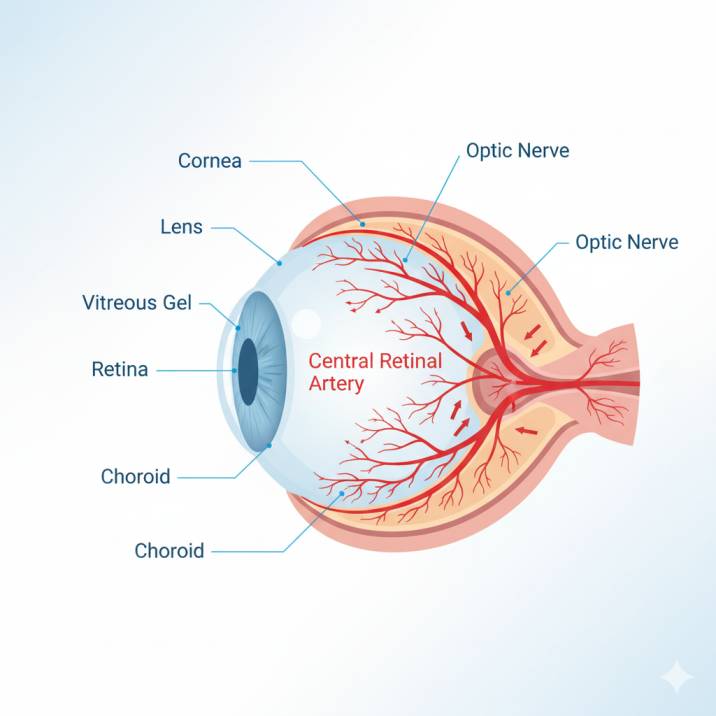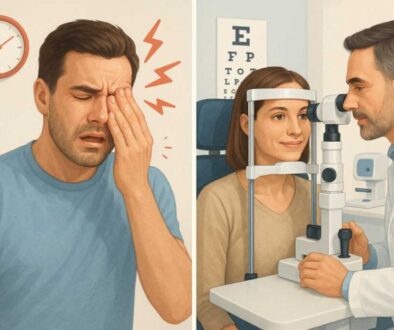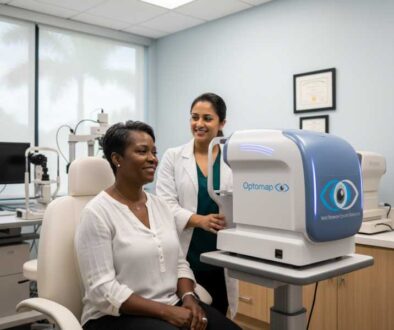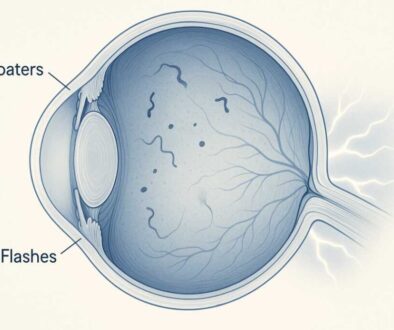Sudden Vision Loss: Emergency Signs & Treatment Guide
Understanding When Eye Emergencies Demand Immediate Action
When you suddenly lose vision in one or both eyes, every minute counts. As your trusted vision guardians in Tamarac, we want you to understand that sudden vision loss is always a medical emergency requiring immediate professional evaluation—whether you experience pain or not. The difference between seeking prompt treatment and waiting could determine whether you preserve your sight or face permanent vision loss.
Sudden vision loss affects more than 7 million Americans annually and represents one of the most urgent situations in eye care. This comprehensive guide will help you recognize the warning signs, understand the potential causes, and know exactly what to do if this frightening situation happens to you or a loved one.
If you’re experiencing sudden vision loss right now, call 911 or visit the nearest emergency room immediately. For urgent eye care questions, contact West Broward Eyecare Associates.
What Qualifies as Sudden Vision Loss?
Sudden vision loss means any rapid decrease in your ability to see, whether it develops within seconds, minutes, or over a few days. Medical professionals consider all these timeframes urgent emergencies because the underlying causes often require immediate intervention to prevent permanent damage.
Types of Sudden Vision Loss
Vision loss can manifest in several ways:
Total Vision Loss: Complete blackout or near-complete loss of sight in one or both eyes
Partial Vision Loss: Loss of vision in specific areas of your visual field, such as:
- Central vision (what you see directly in front of you)
- Peripheral vision (side vision)
- A curtain-like shadow moving across your field of view
Temporary Vision Loss: Brief episodes where vision disappears and returns, sometimes called transient vision loss or amaurosis fugax
Even if your vision returns quickly on its own, you still need an emergency evaluation. Temporary vision loss can signal an impending stroke or indicate serious eye conditions that may worsen without treatment.
Critical Warning Signs That Demand Emergency Care
If you experience any of these symptoms, call 911 or have someone drive you immediately to the nearest emergency department or urgent eye care clinic:
Sudden Vision Changes
- Abrupt loss of vision in one or both eyes
- Rapid blurring that worsens within minutes
- A gray or dark curtain descending over your visual field
- Complete blackout of vision, even briefly
Visual Disturbances
- Sudden onset of numerous new floaters (dark spots or squiggly lines)
- Flashing lights, especially in peripheral vision
- Rainbow-colored halos around lights
- Sudden appearance of what looks like a veil or shadow
Associated Symptoms
- Severe eye pain with vision changes
- Red, painful eye with decreased vision
- Headache accompanying vision loss
- Nausea and vomiting with eye symptoms
- Visual changes after eye injury or trauma
Remember: Sudden vision loss is painless in many serious conditions. The absence of pain does not mean the situation is less urgent.
Common Causes of Sudden Vision Loss
Understanding what can cause sudden vision loss helps you appreciate why immediate medical attention is so critical. The window for effective treatment is often measured in hours, not days.
1. Retinal Detachment: When Time Is Sight
Retinal detachment occurs when the light-sensitive tissue at the back of your eye pulls away from its supporting structures. Without immediate treatment, this condition leads to permanent vision loss.
Warning Signs:
- Sudden increase in floaters
- Flashing lights
- A shadow or a curtain moving across your vision
- Blurred or distorted vision
What happens: The retina receives oxygen and nutrients from the underlying blood vessels. When detached, retinal cells begin dying within hours, making this a true race against time.
Treatment Urgency: Emergency surgery is typically required within 24-48 hours. The procedure may involve laser treatment, freezing therapy (cryopexy), or surgical techniques like pneumatic retinopexy or scleral buckling. Success rates reach 90% when treated promptly, but delays dramatically reduce the chances of full vision recovery.
Risk Factors:
- Severe nearsightedness
- Previous eye surgery or injury
- Family history of retinal detachment
- Diabetic retinopathy
- Age-related changes in vitreous gel
Learn more about retinal detachment treatment at West Broward Eyecare Associates
2. Acute Angle-Closure Glaucoma: A Painful Emergency
This condition occurs when fluid drainage in your eye suddenly becomes blocked, causing intraocular pressure to spike rapidly—sometimes reaching 60-80 mm Hg (normal is 10-21 mm Hg).
Distinctive Symptoms:
- Severe eye pain
- Intense headache
- Nausea and vomiting
- Blurred vision
- Rainbow halos around lights
- Red, hard eye
What happens: The iris can block the drainage angle between your cornea and iris, preventing fluid from leaving your eye. The resulting pressure surge can damage your optic nerve within hours.
Treatment Urgency: This represents a true ophthalmic emergency requiring treatment within hours to prevent permanent blindness. Initial treatment includes medications to rapidly lower pressure (acetazolamide, mannitol, pilocarpine drops), followed by laser iridotomy to create a new drainage pathway.
Important Note: If you have acute angle-closure glaucoma in one eye, your other eye is at high risk. Preventive treatment for the unaffected eye is typically recommended.
Discover our glaucoma treatment options
3. Central Retinal Artery Occlusion: Eye Stroke
Often called an “eye stroke,” central retinal artery occlusion occurs when a blood clot or plaque blocks the main artery supplying blood to your retina.
Characteristics:
- Suddenly, painless, severe vision loss
- Usually affects only one eye
- May be preceded by temporary vision loss episodes
- Vision loss develops within seconds to minutes
What happens: Just as a brain stroke cuts off blood to brain tissue, an eye stroke deprives retinal cells of oxygen. Without intervention, retinal tissue damage begins within 90-240 minutes.
Treatment Urgency: This is a medical emergency requiring treatment ideally within 4.5 hours for the best chance of vision recovery. Recent research shows that patients may still benefit from treatment within 6-12 hours, particularly with hyperbaric oxygen therapy. Emergency treatments may include ocular massage, medications to lower eye pressure, hyperbaric oxygen therapy, and interventions to dislodge the blockage.
Critical Connection: Eye stroke indicates you’re at high risk for brain stroke. Anyone experiencing this condition needs a comprehensive vascular evaluation and stroke prevention measures.
Risk Factors:
- High blood pressure
- High cholesterol
- Diabetes
- Cardiovascular disease
- Smoking
- Carotid artery disease
- Age over 60
4. Vitreous Hemorrhage: Bleeding in the Eye
This condition involves bleeding into the vitreous gel that fills the center of your eye, obscuring vision like looking through fog or seeing dark floaters.
Common Causes:
- Diabetic retinopathy (most common)
- Retinal tears or detachment
- Eye trauma
- Abnormal blood vessel growth
- Blood clotting disorders
Symptoms:
- Sudden appearance of many floaters
- Red or dark tint to vision
- Blurred or blocked vision
- Flashing lights
Treatment Approach: Mild cases may resolve on their own over weeks to months as the blood clears. Severe cases may require vitrectomy surgery to remove the blood and repair underlying damage. The urgency depends on the underlying cause—if retinal detachment is suspected, treatment is needed within 24-48 hours.
5. Giant Cell Arteritis: Inflammation-Induced Vision Loss
This serious condition involves inflammation of blood vessels, particularly those supplying the head and eyes. It primarily affects people over 50 and requires immediate treatment to prevent bilateral vision loss.
Warning Signs:
- Sudden vision loss (often upon waking)
- Severe headache (especially in temples)
- Scalp tenderness
- Jaw pain when chewing
- Fever, fatigue, or weight loss
- Shoulder or hip pain
Treatment Urgency: CRITICAL—This condition requires immediate high-dose corticosteroid treatment, often starting before diagnosis is confirmed. Without prompt treatment, the second eye can lose vision within days or weeks. If giant cell arteritis is suspected, treatment should begin immediately—even before confirmatory testing.
Diagnosis: Temporal artery biopsy and blood tests (elevated ESR and C-reactive protein) confirm the diagnosis, but treatment should never be delayed waiting for test results.
6. Optic Neuritis: Nerve Inflammation
Optic neuritis involves inflammation of the optic nerve, often associated with multiple sclerosis (MS). While usually not immediately sight-threatening, it requires prompt evaluation and treatment.
Characteristics:
- Vision loss develops over hours to days
- Pain with eye movement
- Color vision changes (especially red desaturation)
- Central vision loss
- May improve spontaneously
Treatment: High-dose intravenous corticosteroids can speed recovery and may reduce the risk of developing MS in some cases. All patients with optic neuritis should undergo neurological evaluation, as 50% will develop MS within 15 years.
What to Do If You Experience Sudden Vision Loss
Immediate Actions (Within Minutes):
-
Stop what you’re doing – Don’t drive, operate machinery, or engage in activities requiring full vision
-
Call 911 – For complete or severe vision loss, especially if accompanied by:
- Stroke symptoms (facial drooping, arm weakness, speech difficulty)
- Severe headache
- Head trauma
- Loss of consciousness
-
Go to the nearest emergency room – If you can’t reach 911 or need immediate transportation
-
Contact an ophthalmologist immediately – Call West Broward Eyecare Associates for urgent eye emergencies during business hours
-
Note the time – Record when your vision loss began, as treatment windows are time-sensitive
-
Don’t drive yourself – Have someone else drive you or call for emergency transport
Information to Provide to Emergency Services:
- When symptoms started (exact time if possible)
- Type of vision loss (complete, partial, one eye, or both)
- Associated symptoms (pain, headache, flashes, floaters)
- Recent eye procedures, injuries, or infections
- Medical history (diabetes, high blood pressure, blood clotting disorders)
- Current medications, especially blood thinners
- History of stroke or heart disease
Diagnostic Tests You May Undergo
To determine the cause of your sudden vision loss, your eye care team may perform several tests:
Comprehensive Eye Examination:
- Visual acuity testing
- Pupil response evaluation
- Intraocular pressure measurement
- Dilated fundus examination
- Visual field testing
Advanced Imaging:
- Optical Coherence Tomography (OCT) – Detailed retinal imaging
- Fundus photography – Retinal photographs for documentation
- Fluorescein angiography – Evaluates blood flow in the retina
- Ultrasound – Useful when the retina can’t be visualized
Systemic Testing (if indicated):
- Blood tests (ESR, C-reactive protein, complete blood count)
- Blood pressure monitoring
- Blood sugar testing
- Carotid artery imaging
- Neurological imaging (CT or MRI)
At West Broward Eyecare Associates, we have state-of-the-art diagnostic equipment on-site, allowing us to quickly identify vision-threatening conditions and initiate treatment without delay.
Treatment Options by Condition
Retinal Detachment:
- Pneumatic retinopexy (gas bubble injection)
- Laser photocoagulation
- Cryopexy (freezing treatment)
- Scleral buckle surgery
- Vitrectomy surgery
Acute Angle-Closure Glaucoma:
- Immediate pressure-lowering medications
- Laser peripheral iridotomy
- Surgical iridectomy (if laser fails)
Central Retinal Artery Occlusion:
- Ocular massage
- Anterior chamber paracentesis
- Hyperbaric oxygen therapy (most effective within 9 hours)
- Intravenous thrombolytics (in select cases)
- Stroke workup and prevention
Vitreous Hemorrhage:
- Observation for mild cases
- Vitrectomy surgery for severe or non-resolving cases
- Treatment of underlying cause (diabetic retinopathy, tears)
Giant Cell Arteritis:
- High-dose corticosteroids (started immediately)
- Temporal artery biopsy (within 1-2 weeks of starting steroids)
- Long-term steroid therapy with gradual taper
Optic Neuritis:
- High-dose intravenous methylprednisolone
- Oral corticosteroids (in some cases)
- Neurological evaluation for MS
Prevention: Reducing Your Risk of Sudden Vision Loss
While you can’t prevent all causes of sudden vision loss, you can significantly reduce your risk:
Regular Eye Examinations:
- Annual comprehensive eye exams, especially if you’re over 40
- More frequent exams if you have diabetes, high blood pressure, or a family history of eye disease
Manage Chronic Conditions:
- Control blood sugar if diabetic
- Maintain healthy blood pressure
- Manage cholesterol levels
- Treat cardiovascular disease
Healthy Lifestyle Choices:
- Don’t smoke (smoking doubles your risk of macular degeneration and increases stroke risk)
- Maintain a healthy weight
- Exercise regularly
- Eat a diet rich in fruits, vegetables, and omega-3 fatty acids
- Limit alcohol consumption
Eye Protection:
- Wear protective eyewear during sports and hazardous activities
- Use proper eye protection in occupational settings
- Wear sunglasses with UV protection
Know Your Family History:
- Inform your eye doctor of family history of retinal detachment, glaucoma, or other eye diseases
- Be extra vigilant if you have risk factors
Address Warning Signs:
- New floaters or flashes require the same-day evaluation
- Any change in vision should be evaluated promptly
- Don’t ignore temporary vision loss episodes
Schedule your comprehensive eye exam today to protect your vision for the future.
When to Seek Emergency Care vs. Urgent Care vs. Routine Appointment
Understanding the level of urgency helps you make the right decision:
Call 911 or Go to the Emergency Room Immediately:
- Sudden, complete, or severe vision loss
- Vision loss with stroke symptoms
- Vision loss after head trauma
- Painful red eye with vision loss
- Vision loss with a severe headache in someone over 50
Contact Your Ophthalmologist for Same-Day Urgent Appointment:
- New onset of floaters and flashes
- Curtain or shadow across vision
- Sudden increase in floaters
- Temporary vision loss (even if resolved)
- Gradual but progressive vision loss over hours
Schedule an Appointment Within a Few Days:
- Mild, gradual vision changes
- Need for glasses prescription update
- Eye discomfort without vision loss
Contact Your Eye Doctor Soon:
- Slowly progressing vision changes
- Need for prescription update
- Routine eye exam overdue
- Non-urgent eye concerns
When in Doubt, Choose Emergency Care: It’s always better to seek evaluation and discover the problem isn’t urgent than to wait and risk permanent vision loss.
What Makes West Broward Eyecare Associates Your Best Choice for Eye Emergencies
Located in Tamarac, Florida, we understand that eye emergencies don’t wait for convenient times. As your vision guardians, we provide:
Immediate Access to Expert Care
Our team combines decades of experience with the latest diagnostic technology to quickly identify and treat vision-threatening conditions. We’re equipped to handle everything from retinal detachment to acute glaucoma, providing the specialized care you need when every minute counts.
Comprehensive Emergency Services
Unlike general urgent care facilities, we have:
- Advanced imaging equipment (OCT, fundus photography)
- On-site treatment capabilities
- Laser therapy options
- Coordination with retinal specialists and ophthalmologists when needed
- Understanding of complex eye emergencies
Family-Centered Emergency Care
We recognize that eye emergencies affect the entire family. Whether you’re a worried parent bringing in a child with eye injury or you’re managing your own sudden vision changes, we provide:
- Clear, patient explanations of what’s happening
- Step-by-step guidance through treatment options
- Support for both immediate and follow-up care
- Coordination with your primary care doctor when needed
Serving the Tamarac Community
We’re your neighbors, deeply rooted in the West Broward community. We accept most insurance plans, including Medicare and Medicaid, because we believe everyone deserves access to emergency eye care when they need it most.
Serving: Tamarac, Lauderhill, Sunrise, Plantation, Fort Lauderdale, and surrounding Broward County communities.
Recent Research Supporting Urgent Vision Loss Care
Recent research continues to validate the importance of rapid response to sudden vision loss:
-
American Academy of Family Physicians (January 2025): Published research confirming that common and dangerous conditions causing sudden vision loss—including acute angle-closure glaucoma, retinal detachment, retinal artery occlusion, giant cell arteritis, and optic neuritis—require immediate intervention to prevent permanent vision damage. The study emphasizes that family physicians must recognize these emergencies and facilitate rapid specialist evaluation.
-
Mayo Clinic (October 2024): Research on central retinal artery occlusion (eye stroke) demonstrates that treatment outcomes are significantly better when hyperbaric oxygen therapy is administered within 9 hours of symptom onset. The study of 41 patients found that 70% of those who received treatment within 9 hours had clinically meaningful improvement in vision, compared to lower success rates with delayed treatment.
-
American Heart Association Scientific Statement (Updated 2024-2025): Comprehensive guidelines establish that the optimal treatment window for central retinal artery occlusion is within 4.5 hours, though interventions within 6-12 hours may still provide benefit. The research emphasizes treating CRAO as a medical emergency equivalent to stroke, requiring immediate action and comprehensive vascular evaluation.
The Bottom Line: Vision Loss Is Always an Emergency
Your vision is irreplaceable, and many causes of sudden vision loss have narrow treatment windows. The key message is simple: sudden vision loss—whether painful or painless, temporary or persistent, partial or complete—always requires immediate professional evaluation.
Don’t wait to see if symptoms improve. Don’t convince yourself it’s “probably nothing.” Don’t hesitate because you’re worried about overreacting. When it comes to your eyesight, seeking immediate care is never an overreaction.
Take Action: What to Do Right Now
If you or someone you know experiences sudden vision loss:
- Call 911 or have someone drive you immediately to the nearest emergency department or urgent eye care clinic
- Don’t drive yourself if you have vision loss
- Note the timing of when symptoms began
- Bring medications and medical information with you
- Don’t delay, hoping symptoms will improve
For non-emergency eye concerns or to schedule a comprehensive eye exam:
If you have risk factors for vision-threatening conditions but haven’t had a recent eye exam, schedule one today. Prevention and early detection are your best defenses against vision loss.
Your Vision Deserves Expert, Compassionate Care
At West Broward Eyecare Associates, we’re committed to protecting your vision through every stage of life. Whether you need emergency care for sudden vision loss, comprehensive eye examinations, or ongoing management of eye conditions, we’re here as your trusted partners in eye health.
Don’t wait until an emergency happens. If you’re overdue for an eye exam or have concerns about your vision, contact us today. We’re here to serve our Tamarac community with the expertise, technology, and compassionate care you deserve.
This article is for informational purposes only and does not substitute for professional medical advice. If you experience sudden vision loss, seek immediate emergency medical attention. For non-emergency eye care questions or to schedule an exam, contact West Broward Eyecare Associates.
FAQs
-
Sudden vision loss typically results from blocked blood vessels (eye stroke), retinal detachment, eye injury, or bleeding inside the eye. Stroke, acute glaucoma, and optic nerve inflammation can also cause rapid vision loss.





